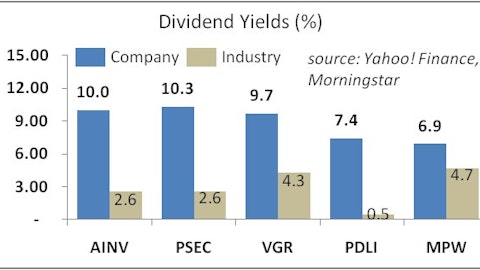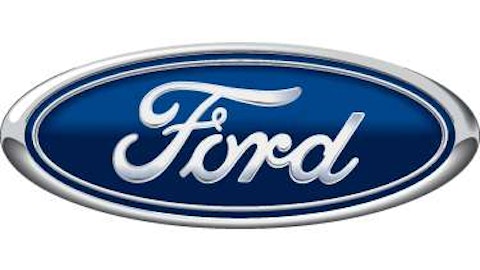Cigarette stocks offer extremely high dividend yields, some even higher than the yields of the big telecom companies. But among the four largest American-based cigarette companies a distinct dichotomy emerges. On the one side you have Altria Group, Inc. (NYSE:MO), Lorillard Inc. (NYSE:LO), and Reynolds American, Inc. (NYSE:RAI), all of which derive much of their revenue from the United States. On the other side you have Philip Morris International Inc. (NYSE:PM) which, while based in the US, sells exclusively in international markets. Philip Morris was spun-off from Altria in 2008, with Altria retaining some Philip Morris brands within the US. This allowed Philip Morris to focus solely on high-growth international markets.
This is a classic battle of dividend yield vs. dividend growth. Philip Morris, while likely to grow much faster than its competitors, offers the lowest dividend yield of the four. Does this higher growth make Philip Morris a better value, or do the higher yields of the other three companies make up for their slow-growth trajectories?
A Tale of Yields and Growth
As you can see from the table below, Philip Morris’ dividend yield falls far short of the competition.
| Company | Yield |
|---|---|
| Philip Morris | 3.86% |
| Altria | 5.15% |
| Lorillard | 5.23% |
| Reynolds American | 5.31% |
While a 3.86% dividend yield is well above the S&P 500 average, it pales in comparison to the 5+% yields offered by Altria, Lorillard, and Reynolds.
Dividend yield is often the first thing that dividend investors look at when judging an investment. Unfortunately, for less prudent investors it’s also the last thing they look at. Dividend growth is equally important.
Philip Morris began its quarterly dividend payment at $0.46 per share after its spin-off in 2008, quickly raising it the very next quarter to $0.54 per share. The first full year of operation, 2009, saw a total dividend of $2.24 per share. This has grown to $3.24 in 2012, an increase of 44.6% in just three years, or 13.1% annualized.
Since Altria spun off two different business in 2007 and 2008, Kraft and Philip Morris, the dividend of the remaining company was reduced from that of the former company containing both divisions. In 2009, the first full year after the spin-offs, Altria paid a total dividend of $1.32 per share, growing to $1.70 in 2012. This is an increase of 28.8%, or 8.8% annualized.
Lorillard completed a 3-for-1 stock split on Jan. 16, so I’ve adjusted its dividend payments to reflect this. In 2009 Lorillard paid a total dividend of $1.28 per share. This has grown to $2.068 per share in 2012, a 61.6% increase, or 17.34% annualized.
Reynolds American has grown its dividend from $1.725 in 2009 to $2.33 in 2012. This is a 35% increase, or 10.54% annualized.
While Philip Morris has grown its dividend faster than both Altria and Reynolds, Lorillard blows the competition out of the water. This goes against the idea that Philip Morris, focusing solely on international markets, should be able to grow faster. One reason is that Lorillard is a much smaller company, with only about $6 billion in annual revenue compared to $31 billion for Philip Morris.
Payout Ratio
The payout ratio is simply the percentage of the free cash flow that is used to pay out dividends. If the payout ratio is low this means that dividend growth can come from both increasing earnings and increasing the payout ratio. Alternatively, if the payout ratio is high, this could mean that dividend growth will slow from historical levels. Let’s compare the payout ratio from 2009-2011 for these three companies. (Since all of the companies haven’t reported full 2012 results yet I don’t have FCF for 2012)
Payout Ratio
| Company | 2009 | 2010 | 2011 |
|---|---|---|---|
| Philip Morris | 60.9% | 51.5% | 51.6% |
| Altria | 86.2% | 116.8% | 93.0% |
| Lorillard | 64.1% | 61.5% | 64.2% |
| Reynolds American | 76.9% | 98.7% | 102.3% |
Data from Morningstar
Both Altria and Reynolds had a year where they paid out more in dividends then they had in free cash flow. It’s no surprise, then, that these two companies also had the lowest dividend growth rate. Both Philip Morris and Lorillard have reasonable payout ratios.
It appears that Lorillard is the clear winner here. With a 5.23% dividend yield, a 3-year dividend growth rate of 17.34%, and a reasonable payout ratio, Lorillard offers the best of both worlds. In addition, Lorillard has been using its ample free cash flow to aggressively buy-back shares, reducing its share count from 494 million at the end of 2009 to 391 million at the end of Q3 2012. This is a 20% reduction in less than three years. This means that a third of the dividend growth since 2009 has been driven by share buybacks, while the remaining two-thirds has been driven by FCF growth. Even if FCF stays flat from here on out share buybacks alone can drive the dividend per share higher.
Is Lorillard A Value?
Even without doing any sort of calculation its clear that Lorillard is a fantastic dividend stock. The question is: how fast does the dividend need to grow to justify the current share price? To answer this I’ll use the dividend discount model. I’ll assume that after ten years the dividend will grow at a perpetual rate of 3%, and through trial and error find the 10-year growth rate which yields the current stock price. For my discount rate I’ll use 8%, roughly the long-term growth rate of the market as a whole. Here is the result.


The Bottom Line
Lorillard is trading at a level which assumes dividend growth will be almost nonexistent going forward. Lorillard sells mainly menthol cigarettes, which are at risk of facing increased regulation from the US government. If this occurs then profitability will certainly suffer. But the stock is so cheap that even an anemic 3% annual increase renders it undervalued. Lorillard offers a fantastic addition to a dividend-focused portfolio.
The article The Best Tobacco Stock originally appeared on Fool.com and is written by Timothy Green.
Copyright © 1995 – 2013 The Motley Fool, LLC. All rights reserved. The Motley Fool has a disclosure policy.





